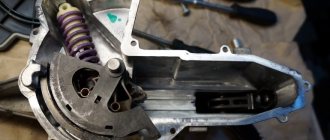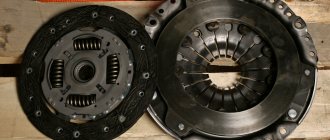There is hardly any need to talk once again about Russians’ distrust of the domestic auto industry. Too many failures and mistakes have been made by engineers and designers. Nevertheless, in 2015 the premiere of the domestic car Lada Vesta took place, which was supposed to become a bestseller, along with the X-ray crossover. Let's take a closer look at whether a manual car is worth the money. The Lada Vesta, about which there are already more than enough reviews, is a rather interesting car, both externally and internally.
Some general information
First of all, I would like to note that there is no automatic transmission for Vesta as such. The management stated that if it is implemented, it will only be in a few years. It is quite possible that sales will not go as expected, so installing an automatic transmission will not be advisable at all. Therefore, at present it is possible to buy a car only with a manual transmission. "Lada Vesta", reviews of which will be discussed in this article, is truly a big leap forward for the domestic automobile industry. Of course, to catch up with European and Asian competitors, you will have to work hard, and it will take quite a lot of time.
But we can already say that some success has been achieved. The design of the car attracts attention, but it is quite difficult to call it unusual. As for the interior, there are several more interesting details here than on the outside. Regarding the technical part, this is an ordinary sedan, which is unlikely to be driven, because there are only 2 engines to choose from: 1.6 and 1.6 liters from Nissan. Both of them are equipped with a manual transmission.
A little about the car's exterior
The first impression of any car is formed by its appearance. As for Vesta, its design is somewhat similar to Volvo. This is not surprising, because a former Volvo employee took part in the development. Nevertheless, there is something to see here. One of the stylistic features is the presence of zigzag stamping on the side parts of the car. As for the optics, there is some angularity as well as elongation. The car has a predatory look, which is only a plus. As for the rear lights, they can be called quite ordinary. Although they could have been made a little larger, since against the background of the massive rear of the car they look somewhat awkward.
The designers and the emblem have been slightly altered. On Vesta, the boat became noticeably wider, and the sail was divided into several lines. In general, this perfectly decorates the Lada bumper. Well, now let's go further and look into the interior of the car.
What is the difference between the cars?
In the station wagon, the rear side doors have been enlarged and the roof has been raised, so there is more room for passengers. The sedan does not have disc rear brakes found on the SW, with the original version of springs and shock absorbers. A special distinctive feature is the new paint job – bright orange. This color is not intended for other brands.
The station wagon has it, but the sedan does not:
- Locking hatch for drainage on the gas tank.
- Buttons to open the trunk lid.
- Armrests.
- Cup holders.
- Charging connectors for rear passengers.
- Heated rear seats.
The SW equipment looks more impressive and richer. For example, such components:
- Side pillows.
- Heated windshields.
- Sensors for light and rain.
- Alloy wheels.
Besides everything, the Vesta station wagon costs more than the sedan.
Briefly about the interior
As for the interior, the first impression largely depends on the vehicle’s equipment. Of course, even the basic package has everything you need. However, the whole essence is revealed in the most expensive version. There is also a modern multimedia system. Many motorists praise the sound and say that it turned out to be very decent. The wide touch panel in the center of the dashboard looks great. But it is needed here not only as decoration, but to perform a number of tasks, such as sound control, navigation, etc.
The designers used plastic that was moderately hard and durable. The seats are combined, made of fabric and leather. The dashboard also looks rich. You especially pay attention to the color scheme, which turned out to be quite successful. The combination of green and white looks great. The eyes do not get tired, because the colors are saturated, but not bright, and if necessary they can be adjusted. Most motorists were satisfied with the interior, reviews indicate this. Lada Vesta (manual) does not have an electrical package as standard. It is only available in Lux, which is rather a minus, but it was to be expected.
"Lada Vesta" (mechanics): reviews from owners
The first and main thing Vesta drivers pay attention to is the transmission. Many motorists would like to be able to purchase a car with an automatic transmission. Unfortunately, at the moment there is no such possibility. A 5-speed transmission is currently being installed, which was borrowed from. Thanks to the use of the French MPKK, it was possible to significantly reduce vibration and noise levels, which directly affected the level of comfort in the car while driving.
Drivers also note that the Renault manual transmission is quite reliable and perfectly adapted for operation in the Russian Federation. True, the installation of such a transmission somewhat affected the final cost of the car, but, according to the designers, it was worth it. The manual transmission is assembled at the Tolyatti plant. They also plan to install a robotic gearbox in the future, which has been installed on the Grant for a long time. She has been tested and showed her best side.
Vehicle powertrain
The motors installed on Vesta comply with modern Euro-5 environmental standards, so there is no need to talk about their environmental friendliness once again. Drivers are more interested in reliability and engine choice. The base comes with an 8-valve internal combustion engine with a capacity of 87 horsepower. But most experienced drivers prefer to buy a car with a new 16-valve 1.6-liter engine with a power of 106 hp. With. According to many, this particular power unit can be considered optimal. The top-end 1.6-liter engine from the Nissan Sentra boasts a power of 116 hp. s., but will cost a little more.
The developers are already working on the Lada Vesta 1.8 (mechanics). Reviews of this powertrain cannot be found as it has not yet been released. As for power, most likely it will not exceed 130-140 hp. With. But this will be quite enough for a comfortable dynamic ride. In general, motorists prefer to choose a 1.6 engine with a power of 106 hp. With. He is not such a “vegetable” as 87 liters. pp., but also easier to maintain than its more powerful counterpart.
Test drive Lada Vesta with manual transmission
Details Category: Test drive Published 12/27/2015
Yesterday a presentation of the Lada Vesta took place in Naberezhnye Chelny. We took the first test drive of a Lada Vesta with manual transmission . More on impressions below.
Let us remind you that we recently talked about our emotions after a test drive of a Lada Vesta with a “robot” in Kazan. Yesterday we visited the Auto-1 car showroom, where a presentation of the new product took place in Naberezhnye Chelny. During the presentation, a recording was made for a test drive of a Lada Vesta with a manual transmission . Of course, we couldn’t miss the opportunity to compare the Lada Vesta with a “robot” and a manual transmission.
We had to ride this white beauty.
Compared to other test cars, Lada Vesta looks special.
A short paperwork procedure and we go for a test drive.
We have already talked in detail about the convenience and settings of the workplace while driving Vesta.
This time we got a car in the “Comfort” configuration - this is an average configuration: without a rear view camera, touch monitor and other options.
The car is equipped with a 1.6 liter VAZ engine with a power of 106 hp. It is paired with a new five-speed manual transmission, created by AVTOVAZ in partnership with the Renault-Nissan alliance.
After warming up the car a little, we set off for the trip.
What can we say about the “mechanics” on Vesta ? It is qualitatively different from everything that was previously on Lada cars. The lever strokes are not very short, but clear. The lever itself fits comfortably in the hand.
Vesta uses a cable-driven gearbox. You will say that cable-driven gearboxes have long been installed on the same Kalinas and Grants. Yes, but even compared to them, the “mechanics” on the Vesta are clearer, and the gear shifts are smoother.
But the most pleasant difference between the “mechanics” on the Lada Vesta is the sound. Or rather, its absence. Anyone who has driven a Lada car at least a little probably cannot forget these transmission sounds - hum and howl, especially in 2nd gear.
Subconsciously, we expected the same from Vesta. Fortunately, we were wrong. Even when switching from 3rd to 2nd gear with a shift, the box does not make any sounds when releasing the clutch. And the engine noise does not bother the driver and passengers. All this completely erases from your mind the idea that you are driving a domestic car.
By the way, the clutch drive here is also different from the traditional one on VAZ front-wheel drive cars. There is no longer a cable drive, but a hydraulic clutch drive. The pedal has a fairly long stroke and allows you to handle it quite casually - the car still moves off smoothly and without jerking. Again, let's remember the owners of Kalin, Prior and Grant. Remember that annoying clicking sound when you release the clutch pedal? This is how the clutch cable tensioner mechanism installed on the clutch pedal works. Since the clutch drive on Vesta is hydraulic, there is no cable, and therefore no clicking mechanism either. Another plus for acoustic comfort in the cabin.
As we expected, the “mechanics” on Vesta allow you to dose the thrust very accurately. It realizes the potential of the 106-horsepower engine much better than the “robot”. You can drive economically, shifting at medium engine speeds, or you can easily accelerate in 2nd gear to 60-70 km/h. Even with such acceleration, the sound of the engine entering the cabin is muffled—we give Vesta a solid “five” for the sound insulation of the engine compartment.
The anti-rollback protection system also showed itself to be excellent - when you engage a gear and release the brake pedal, the car is held motionless for another 2 seconds, which allows even inexperienced drivers to set off without rolling back.
Let's summarize. As we thought, the manual Lada Vesta more than the robotic one. It is both cheaper than the “robotic” version and more pleasant to operate.
About the packages
There are currently three configurations available for sale:
- "Classic";
- "Comfort";
- "Lux".
The basic configuration is a practically “empty” car in terms of filling. Motorists very often focus the attention of potential buyers on this. But even here there are already options such as L-shaped rear seat cushions, tilt steering, as well as passive and active safety systems. The “Classic” package includes audio preparation.
The “Comfort” revision is not much different from the base, although there are minor changes. More interesting is the luxury package. In this case, the car will be equipped with a rain sensor, heated side mirrors, seats, windows, and will also have parking sensors with a rear view camera. But that's not all. The most attractive thing is the advanced audio system with a large number of settings. Many drivers who have already bought this car advise spending money on a “Lux”, and leave corresponding reviews about it. A manual Lada Vesta in the basic and maximum configurations are two different things.
Station wagon Lada Vesta and Cross version
Lada Vesta station wagon and Cross version Very soon the Lada Vesta model range will be replenished with a completely new version of the already beloved model.
The five-door body of the Lada Vesta will have the same X-shaped headlights and radiator grille, and the stampings on the doors and wings will remain. The rear of the car will change. The fifth door will have a larger glass area thanks to narrowed rear pillars. The sloping roof will be decorated with a radio antenna made in the shape of a fin. And a graceful spoiler will complete the look. In addition to the regular station wagon, the dimensions of which do not differ from the four-door version, the off-road Cross will appear in the Lada Vesta model range. The main difference between the Lada Vesta Cross and a simple station wagon will be the increased ground clearance of up to 190 mm and a plastic body kit throughout the body. Small updates will also affect the interior. Stylish colored inserts will appear in the front panel and on the doors of the car, and the seat trim will be updated with new combinations of materials and colors.
Interesting!
The Lada Vesta station wagon has been repeatedly spotted on public roads. The first production samples have already been delivered to car dealerships. Their sales will begin in early autumn 2022.
The final price for the five-door Lada Vesta model has not been announced. It is known that it will be 50-100 thousand rubles higher than the cost of the sedan. The price for the off-road version of Cross will be approximately 700-800 thousand rubles.
Is it worth the money?
This is precisely the question that interests potential buyers of the Lada Vesta. The thing is, reading reviews can be confusing. Some drivers believe that for this money it is better to buy an already proven Solaris or Rio, while others are more inclined to buy a domestic car. If we talk about prices, today for about 640,000 rubles you can buy a Vesta in the maximum configuration, and the same Solaris only in the base version. But a completely different question is “What is better?” Domestic engineers tried to make the car competitive in this price range. Apparently it turned out great. After all, the build quality here is at a high level. This is partly due to the fact that both designers and Nissan took part in the development. This made it possible to create a “people's car” that would be very reliable and durable. Therefore, such a machine is definitely worth the money spent on it.
Common features of the two models
In addition to the modern look and comfort, the sedan and station wagon still have a lot in common:
- Presentable appearance.
- Dashboard brightness.
- The floor, trunk opening with rear bumper and lights are unchanged.
- Installation of climate control of one system.
- Multifunctional steering wheel.
- Equipped with a powerful gasoline engine.
- Good handling and maneuverability.
- Reliable security system.
- Both cars are designed to overcome the difficulties of Russian roads.
- Ready for high-speed traffic.
- High level of build quality.
In both the sedan and the station wagon, the trunk size remains the same. But there are now compartments for various small things, so there is something to surprise drivers.
A little about the benefits
Let's take a look at the reviews from car owners. The manual Lada Vesta, according to most, is a relatively economical and easy-to-maintain car. As for fuel consumption, in the urban cycle it is about 10-11 liters. In fact, for a 1.6 engine this is not such a good indicator, but it can be called moderate. They also often focus on the chassis. The car responds really well to the slightest movements of the driver. The suspension is reliable and “swallows” most of the unevenness of the road surface. Motorists also appreciated the ground clearance of 178 mm. This is extremely important when operating a car in the Russian Federation.
About the target audience
The constructors and designers were faced with a rather important task - to make sure that the car was in demand among a wide circle of the population. Achieving this is not so easy, but, as it turns out, it is quite possible. The interior of the car is very spacious, despite its small dimensions, so it is perfect for family trips. At the same time, a modern interior with a good audio system and a stylish appearance are an excellent choice for young people. In general, the developers expect that people between 25 and 45 years old will buy the car.
A few important details
Around September 2022, the Lada Vesta 1.8 manual version is expected to be released. Reviews from owners of cars with a 1.6-liter engine indicate that this car will become even more vigorous and high-torque. But the appearance of an automatic transmission may change the situation somewhat. Even 1.6 has a very moderate appetite, and 1.8 with automatic transmission will consume at least 15 liters per hundred. Not every Vesta buyer will be ready for this. After all, now economical cars are still more valued, especially if you look at gasoline prices.
Fraternal twins: how does the Lada Vesta SW Cross differ from the regular SW station wagon
For the most thoughtful - a sheet of text below, for the most impatient - straight to the conclusions:
Higher, but not stronger
If we take the height according to the roof rails, then SW is 2 cm . The ground clearance differs by 2.5 cm - 17.8 versus 20.3 for the SW Cross. Otherwise, the dimensions of the two station wagons also differ slightly: the SW Cross is a little longer, a little wider, all this difference goes into the body kit with which the “Cross” body is carefully wrapped.
If the difference in ground clearance affects the geometric cross-country ability, it is only in those places where it is generally sinful to drive passenger cars. If we take moderately compacted primers, then the Vesta SW can drive in the same places as the Cross.
66.RU
Both station wagons have their own signature body color: the Cross has a fiery red “Mars”, the SW has a gray-beige metallic nicknamed “Carthage”, which, as you know, should be destroyed. For metallic you will have to pay an additional 12,000 , but for exclusive - another 50% more - 18,000.
66.RU
While the exterior dimensions differ, the interior space of both station wagons is identical. Therefore, passengers will be equally comfortable both in SW and in Cross.
66.RU
| The upholstery is gray by default; for the Cross there are red inserts to choose from. Expensive versions come with heated rear seats and a USB port. It is most comfortable to sit behind a driver who is 175–180 cm tall: the legs are even slightly extended. Neither Solaris nor Rio provide such space. But in “Rapid” there is still more space. |
When measured to the shelf, there are 480 liters of usable volume - but this does not take into account the tray and raised floor, which consume 15 liters .
It turns out strange: the trunk is in fact the same as the sedan's. The only advantage is the height of the loads that can be transported: from floor to ceiling there is about 0.6–0.7 m .
66.RU
The organization of space, of course, differs from the sedan: Vesta SW / Cross has two floor level options inside, 14 points for securing luggage nets, a belt for securing a canister with anti-freeze and two niches for various small items. If you remove all this, you can even fit a couple of small bicycles when folded.
66.RU
And some more boring numbers: payload up to 475 kg , another 50 kg can be taken by roof rails.
66.RU
| It is impossible not to note the convenient door handles on the trunk lid: this solution is much more convenient than any straps that we are used to. At the same time, the door is quite heavy, it takes a lot of effort. |
The range of power units for SW / SW Cross is the same, which means the problems are the same. The 1.8-liter engine is not enough either on the highway, or on serpentine roads, or on dirt roads: after an extremely stunted start, you still expect it to blossom at four thousand, but when these tachometer values are reached, the engine still roars more than it is lucky.
manufacturer
Here you can make two discounts at once: firstly, the engines are untested (800 km each), and secondly, it was in the mountains. But, on the one hand, I also received the test 1.6-liter Solaris from Rio untested, but they were driven much more vigorously; on the other hand, Krasnaya Polyana is not so high above sea level that the engine suffers from a lack of oxygen-poor air.
Let's sum it up
Overall, it turned out to be a very good domestic car. Reviews also speak about this. The new Lada Vesta (manual) now costs about 640,000 rubles in the maximum configuration with a slight adjustment. If we talk about the intermediate and maximum configuration, then the difference is 50 thousand. But it’s better to pay a little extra and enjoy to the full what domestic designers have prepared for us. The good thing is that the car did not receive harsh criticism, so the project cannot be called a failure. It is unknown how sales will go further. At the moment, Vesta has overtaken Volkswagen Polo and is confidently holding third place. The first place is occupied by Solaris, and the second by Kia Rio. It will be extremely difficult to catch up with these brands, because they have already won the trust of millions of Russians.
Who are these brands suitable for?
First of all, for the middle class , which will be able to spend almost a million Russian rubles. There were no negative reviews from drivers after a test drive or a specific period of ownership of such brands. There are complaints that the car has been compared to its foreign counterparts, but this is an exaggeration. Don’t forget that all models break down and get into accidents, and repairing a domestic unit is much cheaper than foreign beauties.
Even if repairs are carried out under CASCO, many people wait a long time for foreign spare parts from dealers. The only problem is the prices; they scare away buyers. Those who decided to buy did not regret it. And a driver will be able to drive such a colossus, regardless of gender and age.
The Vesta family continues to expand . It has been published in the media that a sports version will soon be released into series, tests have already been completed. Now there is no more beautiful Vesta SW Cross from the Lada model range on sale. The prejudice that AvtoVAZ products only have shortcomings is gradually disappearing, and positive comments have begun to appear. Such facts fill us with pride in the Russian automotive market and raise hopes for future successful development.
Auto and motorcycleComment










